#the mahabharata
Text
Me: I read Mahabharata for the plot.
The plot:


#When I tell you that these two pairs have me in a chokehold#OH AND MY BOI SHIKHANDI IS INCLUDED AS WELL#mythology memes#incorrect quotes#incorrect mythology#incorrect mythology quotes#hindu mythology#incorrect hindu mythology#incorrect mahabharat quotes#incorrect mahabharata quotes#desiblr#hindublr#hinduism#hindu memes#mahabharat memes#mahabharata memes#the mahabharata#mahabharat#mahabharata#krishna and arjun#krishna x arjun#duryodhan x karna#krishna#lord krishna#krishnablr#arjuna#arjun#duryodhana#karna
292 notes
·
View notes
Text



I made a dust-sleeve cover for my cheap copy of the Mahabharata. It was a nice chill-out project that let me dust off my old designs for some of the characters in it.
You can't tell it here, but Arjuna has pearlescent watercolor on his jewelry and the background square is also done in pearlescent watercolor.
#the mahabharata#arjuna#pandava#mahabharata#traditional art#watercolors and ink pens to be precise#diy projects#I would have liked to do a big full-color portrait of the entire cast but that would take like 10000 years for me to do#so it just gets a simple minimal color pic
23 notes
·
View notes
Note
The mahabharata proves aliens. Gotcha
Aye, as we all know, old texts taken out of cultural and historical context with their contents cherry picked and misrepresented are always evidence of ancient aliens.
14 notes
·
View notes
Text


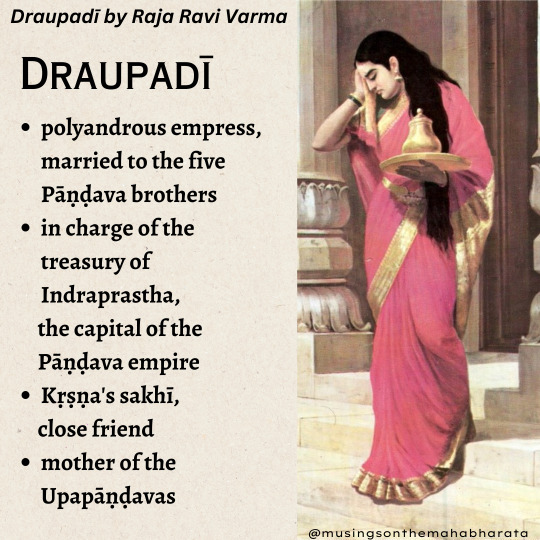

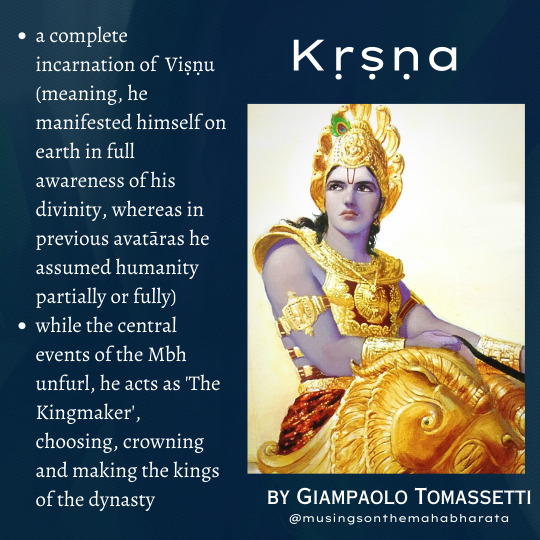



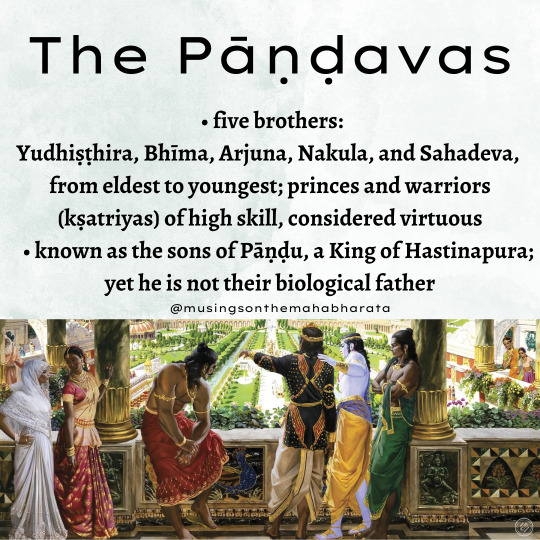
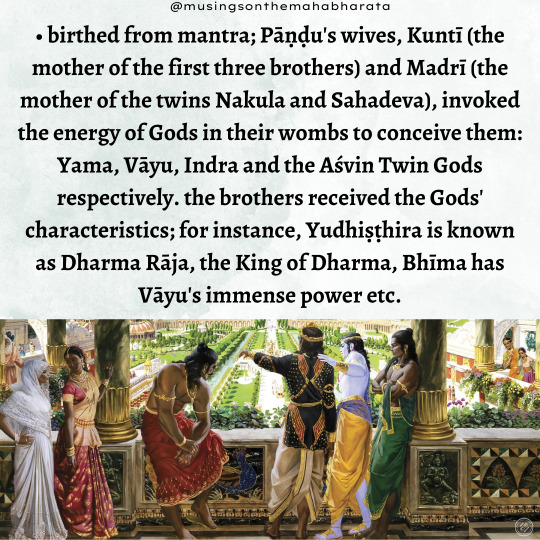
pt. 1 of the main characters from the Mahābhārata series! will expand more on the Pāṇḍavas in the next post.
*last painting credit: Giampaolo Tomassetti!
#mahabharata#mahabharat#the mahabharata#draupadi#krishna#govinda#hari#bhagavad gita#pandavas#yudhisthira#arjuna#bhima#sahadeva#nakula#pandu#hastinapura#mahabharatam#yajnaseni#sri#lakshmi#hare krishna#bhakti#hinduism#religion#itihasa#veda#sanskrit#phd#phd student#phd scholar
18 notes
·
View notes
Text

I've read the entire Mahabharata this year and this is my favorite quote.
#this is completely out of context and it's not at all what the line is saying but I think it's funnier this way#the mahabharata#indian literature#hinduism#Lord Shiva please do not strike me down for my insolence
3 notes
·
View notes
Text
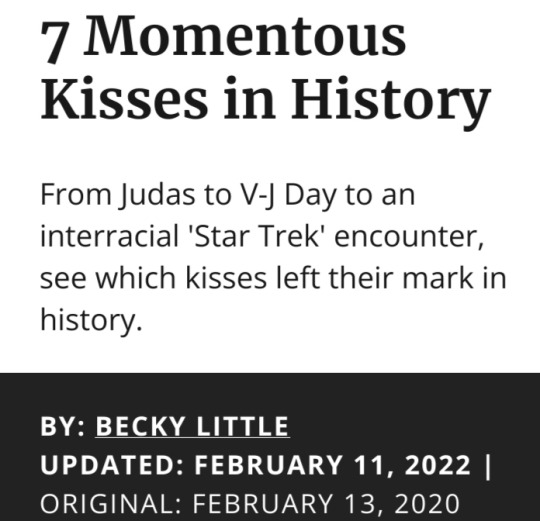
Despite what the song says, a kiss isn’t always just a kiss.
A kiss can be political, because it’s the first of its kind or because it’s between two heads of state.
A kiss can also become iconic when it’s captured on film, even if the kiss itself was invasive and unwanted.
With that in mind, here’s a list of some of the most memorable kisses in history.
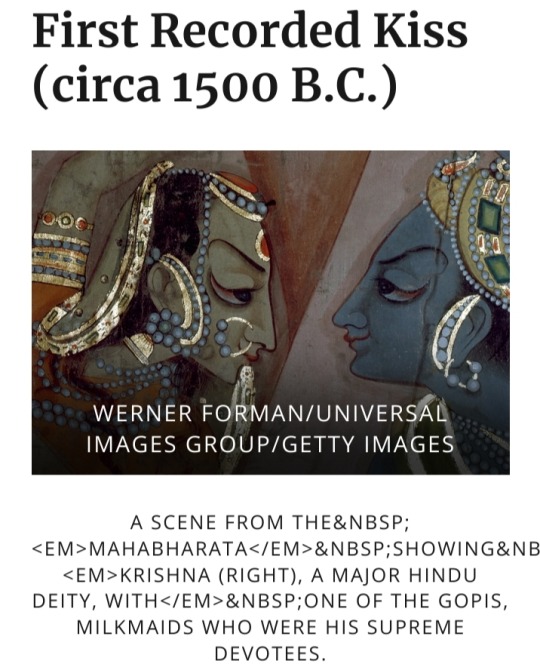
Scholars debate whether kissing began as a trend that spread around the globe, or sprung up organically in different regions.
Whatever the case, the earliest known written mentions of it are in Vedic Sanskrit scriptures circa 1500 B.C., according to research by Vaughn Bryant, an anthropology professor at Texas A&M University.
These scriptures, known as the Vedas, were foundational to the religion of Hinduism.
After that, kissing continued to appear in ancient Indian and Hindu literature.
The Mahabharata, a Sanskrit epic compiled by the 4th century A.D., has a line in which someone “set her mouth to my mouth and made a noise that produced pleasure in me.”
The Kama Sutra, an ancient Sanskrit text on eroticism and love, also has a chapter on kissing that identifies different methods of kissing and types of kisses.
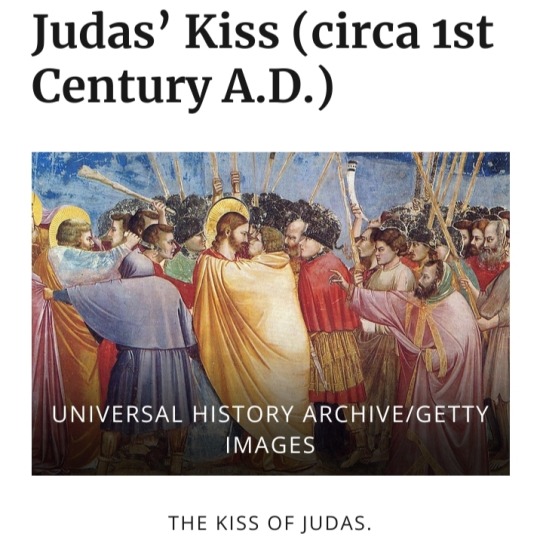
Kissing isn’t just a romantic act. It can also be a sign of friendship or betrayal.
In the Gospels of Matthew and Mark, written circa the 1st century, Judas betrays Jesus by identifying him with a kiss so that armed men can take him away and eventually kill him.
Judas’ kiss has since become a popular storytelling allusion.
It may have inspired the “kiss of death” that appears in mafia literature and film (but was probably never an actual mafia practice).
Perhaps the most famous example is in The Godfather Part II, when Al Pacino’s character gives his brother Fredo the kiss of death for betraying him.
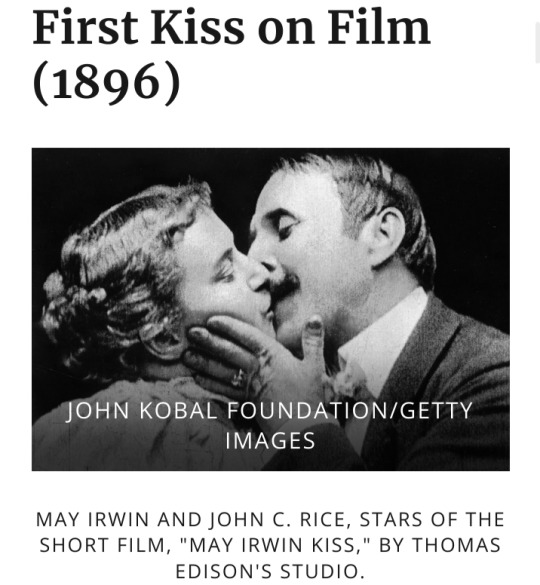
The first people to smooch on film were May Irwin and John C. Rice, who appeared in a short film known variously as May Irwin kiss, Kiss, or The Kiss.
In 1896, the two performers went to Thomas Edison’s studio in New Jersey and reenacted their final kiss scene from a play they were putting on in New York City.
On stage, no one thought the kiss was that sensational. But many felt the close-up footage of them kissing was too risqué.
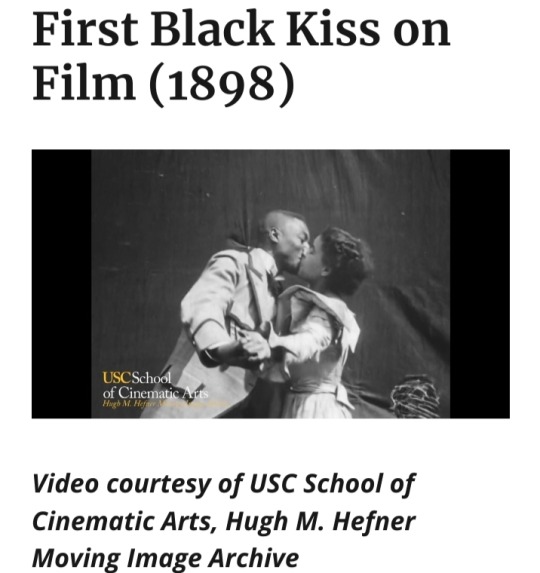
In 1898, black performers Saint Suttle and Gertie Brown starred in a short film titled ''Something Good-Negro Kiss,'' the first film to show Black Americans kissing.
In 2017, film historians rediscovered the footage, which was filmed by a white man named William Selig in Chicago.
“There’s a performance there because they’re dancing with one another, but their kissing has an unmistakable sense of naturalness, pleasure and amusement as well,” Allyson Nadia Field, a professor of cinema and media studies at the University of Chicago who helped identify the film, said in a university press release.
“It is really striking to me, as a historian who works on race and cinema, to think that this kind of artifact could have existed in 1898.”

On the morning of 14 August 1945, patients burst into Greta Zimmer’s Manhattan office claiming the war in Japan was over.
The Austrian immigrant wasn’t sure what to think, so on her lunch break, she went to Times Square in her white dental assistant’s uniform to see what the news ticker said.
The atmosphere there was celebratory. The ticker confirmed that it was indeed V-J Day, and World War II was over.
As Zimmer looked away from the ticker, a Navy sailor named George Mendonsan — who’d started drinking early and mistook Zimmer for a nurse — ran up and aggressively kissed her, leaving his girlfriend behind.
Zimmer struggled to push the stranger off, and they parted ways.
But unbeknownst to both of them, photographers Alfred Eisenstaedt and Victor Jorgensen had each captured the moment, as recounted in The Kissing Sailor: The Mystery Behind The Photo That Ended World War II.
Eisenstaedt’s photo became one of the most iconic WWII images in U.S. history, in part because viewers mistook it for a picture of a Naval officer and nurse celebrating together.
The photo has also stirred controversy, as many people have claimed over the years to be the couple in the image, while others point out that it depicts a nonconsensual moment.
Zimmer said in an interview with the Library of Congress in 2005:
“It wasn’t my choice to be kissed...the guy just came over and kissed or grabbed!”
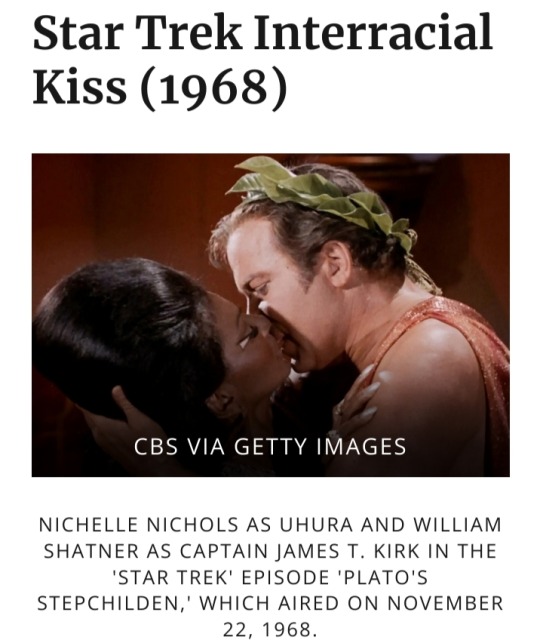
When William Shatner and Nichelle Nichols kissed on a 1968 episode of Star Trek, it was not technically the first interracial kiss on U.S. television.
But it was the one that seemed to have the most cultural impact.
In the episode, titled “Plato’s Stepchildren,” Captain James Kirk and Officer Nyota Uhura encounter aliens who force them to kiss each other through telekinesis.
In Nichols’ book Beyond Uhura: Star Trek and Other Memories, she recalls that NBC was worried how white Americans would react to the scene, so they asked the actors to film two scenes: one with a kiss and one without a kiss.
However, Nichols and Shatner purposefully messed up all of the kissless takes in order to ensure that NBC aired the kissing scene.

During the Cold War, leaders of communist states often greeted each other with what’s called the “socialist fraternal kiss.”
This could be on the cheek or the mouth, but the most famous example is French photographer Régis Bossu’s 1979 picture of the Soviet Union’s Leonid Brezhnev and East Germany’s Erich Honecker kissing on the mouth.
The kiss occurred when Brezhnev visited East Berlin to celebrate the 30th anniversary of the German Democratic Republic (i.e., East Germany).
When the Berlin Wall came down in 1989, the Soviet artist Dmitri Vrubel recreated the image in a mural on the wall’s east side.
He captioned it: “My God, Help Me to Survive This Deadly Love.”
#Memorable Kisses in History#kiss#history#Vedic Sanskrit scriptures#Vedas#The Mahabharata#The Kama Sutra#Judas#Jesus#May Irwin#John C. Rice#Saint Suttle#Gertie Brown#William Selig#Greta Zimmer#Alfred Eisenstaedt#Victor Jorgensen#V-J Day#World War II#Star Trek#William Shatner#Nichelle Nichols#Socialist Fraternal Kiss#Régis Bossu#Leonid Brezhnev#Erich Honecker#German Democratic Republic#Berlin Wall#Dmitri Vrubel#Judas Kiss
2 notes
·
View notes
Text
TOP 05 FAVORITE TYPES OF STORIES
@faintingheroine @storytellergirl @princesssarisa @softlytowardthesun @the-blue-fairie @themousefromfantasyland @superkingofpriderock @metropolitan-mutant-of-ark @captain-dad @angelixgutz @parxsisburning @amalthea9 @darasuum @marquisedemasque @filmcityworld1
01. The Search for the Lost Husband and The Persecuted Lady


Those are considered the two most widespread kind of folktales. What personally touches me the most about these stories is how they explore the resilience of its female heroines, wich we often underestimake as weakness in real life women.
The Search for the Lost Husband touches on the anxiety about arranged marriages, and how women feared they would be sold by their fathers to wild, monstrous beasts, specially because their husbands are full of secrets. Them the heroines break a taboo, discovering the secret, wich makes the husband depart full of fears and insecurity, while the heroine, having grown in love for the husband, reveals courage and confidence to go in a long, dangerous journey to, now in her own terms, win back her beloved. Rather than end the narrative with the marriage celebrations, this kind of story explores what it takes to keep the marriage.
The Persecuted Lady touches in the domestic drama of women who suffer familial abuse, be it the work force exploitation imposed by a stepmother, the appearance shaming imposed by a birth mother, the sexist neglect of a father or grandfather, or the sexual harassment committed by a father. In some tales, the heroines suffer in silence at their own homes, in others, usually under a disguise that makes her look ugly by societal standards (like a straw coat or an animal’s skin), she runs away and works in servitude in another place, also suffering abuse from the employers, until she has the chance to enjoy at least three festive occasions and catch the eyes of a handsome and young rich suitor (usually a Prince), who uses a piece of garment like a shoe or ring to identify the heroine and marry her. The heroine has a long time to cope with harsh situations, but keeps hopefull for better days, and finds the love and happiness that she didn’t had back at home.
My favorite Search for the Lost Husband tales are The Black Bull of Norroway, The Singing Springing Lark and The Iron Stove. My favorite Persecuted Lady tales are Dona Labismínia, Bicho de Palha, Maria Borralheira, Donkeyskin, Thousand Furs, Princess in a Leather Burqa, Florinda, The Three Sisters, The Tale of Popelka, Tattercoats and Cap’O Rushes.
02. The Story Inside the Story

This is when one character presents a fictional narrative to another character, and the narrative presented is just as engaging as the in universe “real” characters we have been accompanying. Sometimes the characters are just amusing themselves with a fun story, and other times the story has a thematic moral relevance to the “real life” situation they are living. The Story Inside the Story can take the form of A Book Within the Book, A Play Within the Play, A Movie Within the Movie, and so forward. The most famous example, and still my favorite, of Story Inside the Story is probably the One Thousand and One Nights book. Other famous examples include Geoffrey Chaucer’s Canterbury Tales and Giovanni Boccacio’s Decameron.
03. The Family Saga
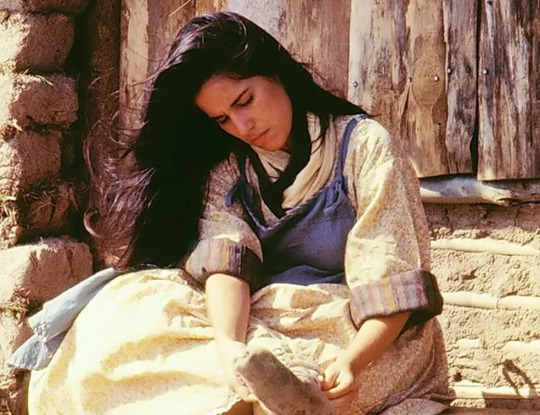
When the story stars being about a character, them this character dies and we move on to see the story of that character’s children, grandchildren, great-grandchildren, all the while we see their different points of view about the political, cultural and societal changes troughout history. My favorite Family Sagas are the myth of The Mahabharata, the myth of King Arthur, Shakespeare’s Henriad and Rose Tetralogy cycle of plays, Érico Veríssimo’s novel Time and the Wind and Gabriel Garcia Marquez’s novel One Hundred Years of Solitude.
04. The Band of Heroes in a Quest

A group of people who in normal circumstance unlikely would meet and talk to each other is united by fantastical circunstances to go on a quest. The object of the quest varies: it could be a treasure, a search for spiritual enlightment, save an innocent in distress, destroy a cursed artifact or eliminate an ancient evil and save the world they know from doom.
My favorite examples Band of Heroes in a Quest are probably the Vampire Hunters from Bram Stoker’s Dracula novel, the Fellowship of the Ring from Tolkien’s Lord of the Rings novel and the Bronze Saints from Toei’s Saint Seiya anime.
05. Deal with the Devil

A human being who makes a deal, out of either desperation or pure ambition, promising his soul to the Devil. Sometimes the deal is selling the soul right away, other times the deal is a bet, where if the human fails at accomplishing a task, the Devil will take their soul to suffer eternally in Hell. We accompany the main character’s journey as he asks: should I use what the Devil gaved me for my own benefit, or should I use it to help other people in need? If I use it to help people in need, so I am redeemed, or my deal with the Devil will forever tarnish me as an evil person? Was I wise in making this deal? Is the Devil truly evil, or is he just testing the evil I may have inside me?
There are two ways in wich this story ends: either the main character escapes with his soul redeemed (usually by a loophole in the contract) or he has sank so low in doing evil deeds that the Devil wins and takes his soul to Hell. The most famous example of a Deal with the Devil kind of story is the german myth of Doctor Faust.
#tumblr mutuals#fandom musings#pop culture#literature#one thousand and one nights#one hundred years of solitude#time and the wind#il decameron#the canterbury tales#the singing springing lark#the black bull of norroway#the iron stove#cap o' rushes#tattercoats#thousandfurs#all kinds of fur#allerleirauh#the mahabharata#faust#folklore#fantasy#mithology
44 notes
·
View notes
Text

Rest in peace, Peter Brook (1925-2022).
27 notes
·
View notes
Text
Krishna and Vishoka: the prestige and renown of charioteers in the Mahabharata
Versus
The White Tiger: the engrained servility of chauffeurs in modern India
Reading The White Tiger back to back with a Mahabharata retelling has me thinking about this a lot.
An Indian friend was telling me about the close relationship he had with his driver back home. How he was like family. I questioned this, saying: how could he be like family when his position is so far below your own? When he has to do everything you say? When he can’t possibly speak out against you? It’s too unequal to be a friendship.
That was my cultural bias talking.
I’m wondering now: what if I grew up on stories of Krishna and Arjuna? Of Vishoka and Bhima? Khastriya with their charioteer companions. Being a driver in India is a respectable job. An aspiration for many people. And I think that goes all the way back to the stories of charioteers in the Mahabharata. It’s deeply engrained in the culture.
In particular, reading about Vishoka from Bhima’s point of view was eye opening. Vishoka, telling Bhima where to shoot in the competition to increase his reputation. Vishoka bravely and eagerly returning just in time for the big war. One is directly above the other in terms of power and position, but Vishoka has a great influence on Bhima as well. I’m seeing that as model of the modern driver/master dynamic in India.
The author of this adaptation (Randamoozham, published 1984) greatly expanded on that relationship, obviously bringing his own modern lens to the story. So history flows both ways. It’s a reflection less of who Vishoka and Bhima originally were, and more of what they have come to represent. There’s a lot to analyze here, and I’m not here to write a PhD thesis, but the wheels are turning in my head.
Without putting any negative or positive judgment on it, it is an interesting cultural attribute.
#the mahabharata#the white tiger#nihil rants#Vishoka#halfhearted textual analysis#if someone did write a thesis on this though I want to read it#I want a harkness discussion on this topic
3 notes
·
View notes
Text

The entire reason I began this blog (and haven’t even bothered really using is properly) is because I mean to do a lot of astrological work here. I’m bored to death of my Instagram and I am now grounded into bed, my orbit has been made so much smaller.
I am going through pregnancy, an eclipse pregnancy at that (I learned that I was pregnant on the last lunar eclipse), a new cycle at the end of the old. I can trace my life against eclipses. Astrological phenomenon is as close to me as my fingertips, as rational as mathematics.
Pregnancy should inspire me to finally get down to doing the work I’ve really wanted to do. I’ve done over 500 readings alone since October, and I’m exhausted. I don’t think I can sit in front of client’s right now, absorbing their energy. I need to sit before myself, instead, and work.
So that’s the entire point of this blog. I need to get down to the Astrology of the body, the physical experience. This is why I’m a palm reader. I am an Astrologer of that which is both exoteric and tangible and the esoteric, the symbolic, which is far more difficult to work with than that which is easily shown.
We are spiraling into a period that will be far more bizarre and difficult than any that we have ever seen before in our own lifetime, but has been seen by others: we are heading towards a time similar to that of the Mahabharat Wars.
1 note
·
View note
Text

With the La Belle et La Bete double feature still languishing and dying of loneliness due to scheduling issues, we've decided to instead celebrate Valentine's Day with a discussion of which of our favorite relationships within fairytales, myths, and classic literature has stood the test of time, and River's gonna rank them!
Who will win?
The socialite and the bootlegger?
The original catgirl and her immortal beloved (that are technically only public domain in Canada)?
The lesbian vampire and her "victim"?
The badass ladies of myth who defied Death itself to save their husbands?
The princess and young man who need one very good boy's help to save them?
The couple with an ending so tragic they spawned the Mid Autumn Festival?
The pairing the Goddess of Love tried to tear apart to the point where even Zeus says she's gone too far?
The ultimate childhood rivals to lovers? And WHY are there so many cats and dogs in this episode?? Find out on this episode of IER TLDR!
Also there might be a sneak peek to a somewhat belated Retelling the News segment at the end, who knows...
#In Each Retelling#IER TDLR#The Great Gatsby#The Ballad of Lost C'Mell#Carmilla (1872)#Egyptian Mythology#Savitri and Satyavan#The Mahabharata#Tsarevitch Ivan the Firebird and the Gray Wolf#fairy tales#Chinese Mythology#Eros and Psyche#Greek Mythology#Anne of Green Gables#podcast#podcast episode
0 notes
Text
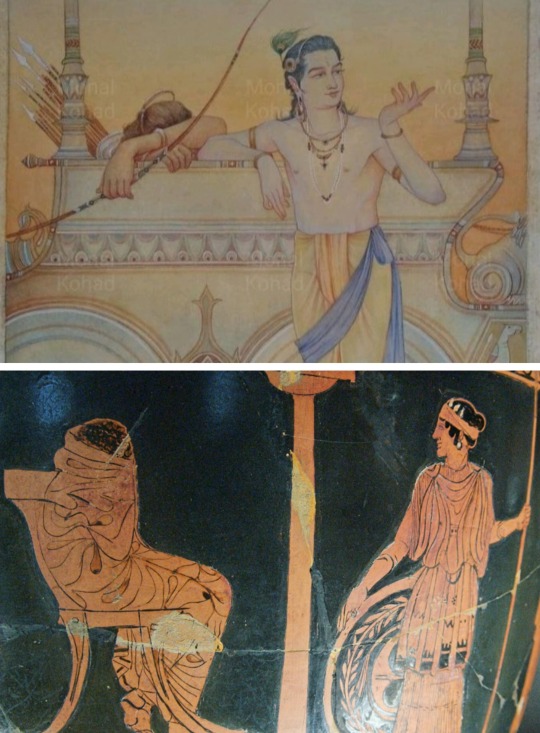
1. Arjun and Krishna
2. Achilles and Thetis
No-context parallels ☠️ (Achilles and Arjun are such moods I-)
BONUS

Me everytime I face a minor inconvenience.
#mythology memes#greek mythology memes#the iliad#iliad#achilles#the mahabharata#mahabharat#mahabharata#mahabharat memes#arjun#arjuna#hindu mythology#desiblr#hindublr#hindu myths#greek myths#desi tumblr#desi tag#hinduism#greek heroes#thetis
101 notes
·
View notes
Text
Peter Brook: the constant innovator | Clara Bauer on the man who revived Theatre des Bouffes du Nord and directed The Mahabharata
Clara Bauer, 47, first met Peter Brook, one in all the most influential theatre administrators of the twentieth century, when she was 19. He was in the viewers when she watched his play, Happy End, in Paris. Then years later, circumstances helped her get a job with him, as his director of manufacturing, working on reveals similar to The Man Who, Le Costume, Tierno Bokar, and The Tragedy of…
View On WordPress
#Atiq Rahimi#Clara Bauer#Compagnie Mia#Happy End#Irina Brook#Is Peter Brook alive?#Kalieaswari Srinivasan#Le Mahabharata#L’Homme Qui#Mallika Sarabhai#Natasha Parry#peter brook#Syngué Sabour#the mahabharata#The Man Who#The Patience Stone#The Prisoner#theatre#Théâtre des Bouffes du Nord#Theatre director#What is Peter Brook known for?#Who was Peter Brook inspired by?
0 notes
Note
How in Sam Hill does the mahabharata prove aliens????
It literally doesn't. Ancient alien theorists just claim it does based on misrepresentation and distortion of what it actually says, like they do with all ancient myths, texts, and traditions they can get their hands on.
12 notes
·
View notes
Text

3K notes
·
View notes
Text

The comedic value of the Mahabharata is under appreciated
8 notes
·
View notes